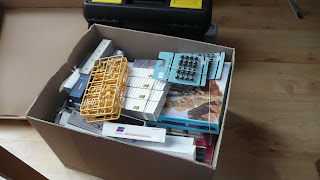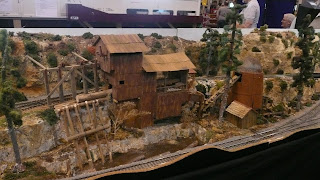I took my completed gunderson stack cars over to the clubhouse to try them out, and discovered that my measuring for the bridge height on my freemo module was a little off. I'm using 2 inch insulation foam for the landscape, and that puts my road surface with another 1.5 inches height difference needed to clear doublestack cars.
I'd suspected that I might not have enough height for the bridge to clear doublestacks, but as I planned to model an arched bridge I hoped that there would be enough distance to get the extra 1.5 inch height difference without needing to raise the road level. Sadly there wasn't.
I've added extra 'ramps' onto either side of the bridge road to help give extra clearance to the taller trains.
This is the bridge I am planning to build for my module, it's based on a prototype on Elkton Rd in Virginia, and has a really interesting metal frame with wooden road surface. I will need to make my version slightly more extreme to clear the trains.



































































